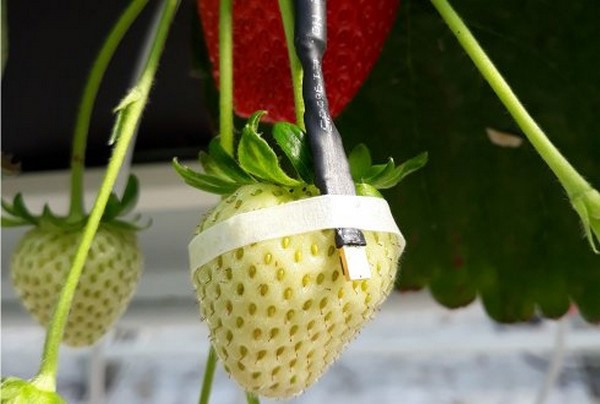Powdery mildew is a dreaded disease in strawberry cultivation. The fungus spreads quickly, and infected strawberry fruits cannot be sold. The Business Unit Greenhouse Horticulture and Flower Bulbs of Wageningen University & Research is investigating whether climate control in the greenhouse can prevent the spread of powdery mildew. To this end, WUR is zooming into the microclimate around the crop.
Powdery mildew on strawberry is caused by the fungus Podosphaera aphanis. The spores of the fungus are distributed through the air. When they land on a leaf or fruit, they germinate and produce mycelium. The fungus looks like powder.
The fungus can be controlled with chemical agents, but strawberry cultivation wants to take a big step towards sustainability. However, there are hardly any efficient biological control agents. And so WUR is looking at the possibility of controlling the climate in a greenhouse in such a way that it prevents germination of spores and development of mycelium.

Spreading quicky
Research shows that germination of powdery mildew spores thrives in high relative humidity. The mycelium grows best at a low relative humidity. And since the air is relatively humid at night and relatively dry during the day, powdery mildew can spread very quickly in a greenhouse.
Controlling relative humidity is, therefore, a potential solution. But for this, it is important to know what the climate conditions in the immediate vicinity of the crop are. WUR is researching this micro-climate by attaching small sensors (of 1 millimeter) next to strawberry leaves and fruits (at a distance of 5 millimeters). This shows, among other things, that the relative humidity around a fruits varies more strongly than in the rest of the greenhouse.
Bioassays
Additionally, based on these micro-climate measurements WUR researchers will conduct bioassays investigating which climate conditions allow powdery mildew spores to germinate and develop into mycelium and which not. Mechanically lowering or increasing relative humidity may thus be a potential solution. Important principles are that this is done in a energy-saving manner without stimulating other diseases and pests.
The powdery mildew research will run until the spring of 2022 and is funded by the Kas als Energiebron program.
For more information:
Wageningen University & Research
www.wur.nl
